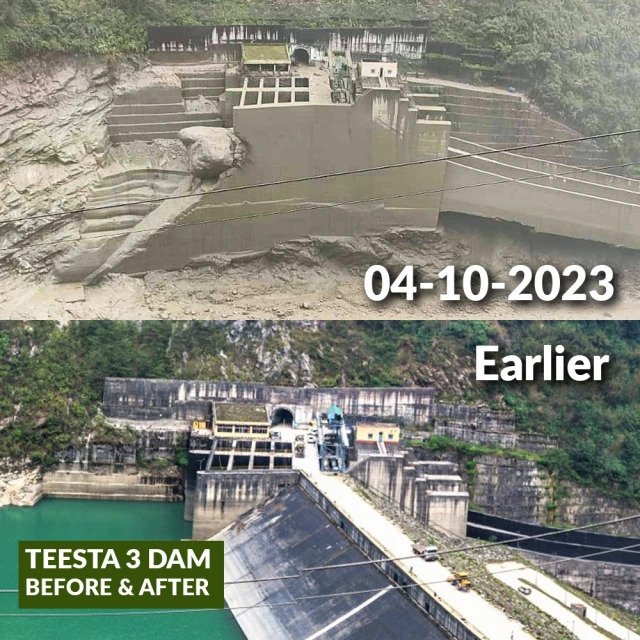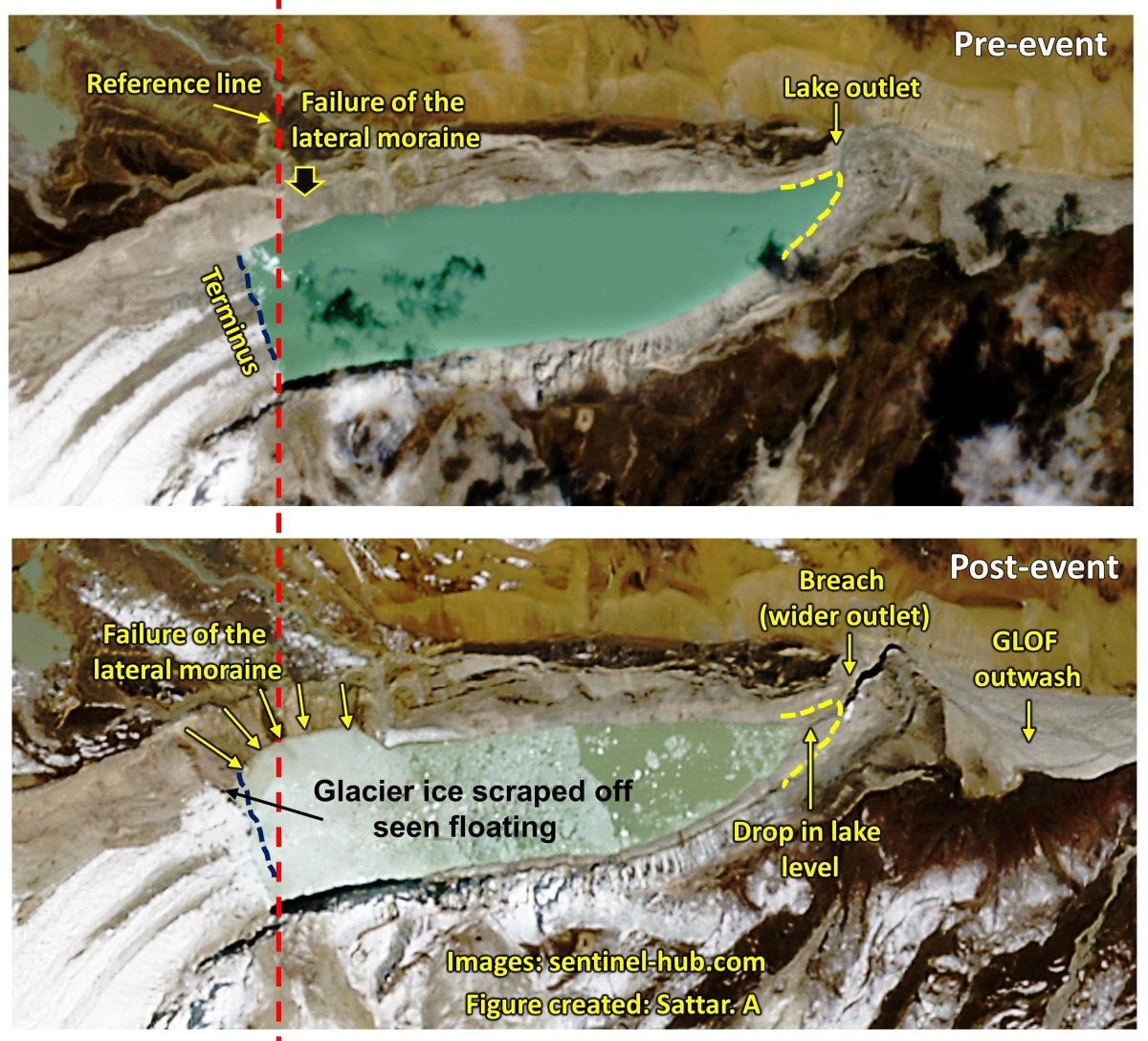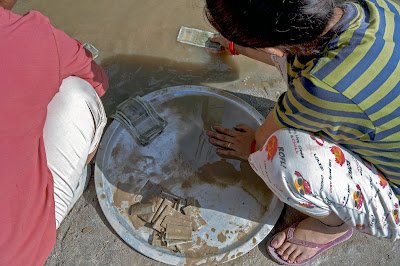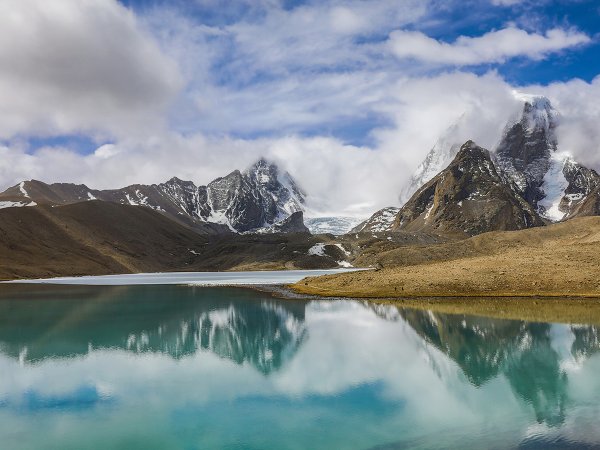The pre-dawn hours of October 4, 2023, were forever etched in the memories of Sikkim's residents. Rasila's* desperate attempt to wake her family was thwarted by a torrent of water that swallowed their home whole. Nirmal's* last glimpse of his family was their cries for help, lost in the churning darkness, as the flood ripped them away. These are just two of the countless heartbreaking stories from survivors of the recent deluge in the Teesta River basin, Sikkim, and downstream areas across India and Bangladesh. (*Names changed for anonymity)
The cause: A glacier lake outburst flood
The culprit behind this disaster was a glacier lake outburst flood (GLOF), a sudden release of water from the from South Lhonak glacial lake that inundated the Teesta River. Water levels were observed to rise by 15 to 20 feet in affected districts in Sikkim and West Bengal States. Additionally, the impacts of this flood were compounded by the sudden release of 5 million cubic meters (2,000 Olympic swimming pools) of water from Sikkim’s largest hydroelectric dam at Chungthang, which failed catastrophically (Fig. 1). The flood also affected hundreds of villages further downstream in Northern Bangladesh and destroyed bridges, highways, and many utilities.

The Government of Sikkim reported that the October 2023 flood resulted in 46 human lives lost, over 77 missing people, and 88,400 people affected. The relief camps set up in four affected districts hosted thousands of rescued and evacuated people.
What is a glacier lake outburst flood?
The sudden release of water from a lake situated at the terminus or surface of a glacier is termed a GLOF.
These lakes are created by moving glaciers that erode the valley bottom topography and create depressions below the glacier surface. When the glacier retreats, as is occurring due to climate change globally, the meltwater can accumulate in this depression and form a lake that may be dammed by the moraine (rocks, finer eroded material, even ice, and other debris the glacier pushed forward in earlier stages when it had been advancing).
A GLOF occurs when the moraine fails, which often results in the release of a catastrophic amount of water.
The most common type of glacier lakes form on the glaciers’ surface (supra-glacier lakes). Less common but larger in size and potentially more damaging are terminal lakes that drain the glaciers. These are naturally dammed by the terminal moraine that blocks water outflow. This is the kind that burst in South Lhonak.
The impact of climate change
Climate change-driven glacier retreats have increased the number and area of glacier lakes throughout the Himalayan range. The state of Sikkim (Fig. 2) has 405 glaciers and approximately 640 glacier lakes. Eleven of these lakes are deemed as potentially hazardous. Moreover, these lakes are located in areas where regular monitoring and installing mitigation strategies are difficult.

Drivers of the Catastrophic South Lhonak GLOF
The South Lhonak lake is among the largest high-altitude glacier lakes in Sikkim and has been the poster child of potential GLOF disasters in the Himalayas. The lake area dramatically increased in size from 0.2 km2 in 1976 to 1.67 km2 in 2023. The volume of water stored in the lake prior to the October 2023 flood was estimated to be 65.8 million m3 with a predicted future volume of 114.8 million m3 (respectively, 26,000 Olympic pools predicted to increase to 45,000). The GLOF potential of South Lhonak lake had been long identified by researchers and notified to the government authorities. It was noted that the lake was susceptible to GLOF threat due to ice-calving from the glacier snout, failure of the moraine, excessive precipitation, earthquakes, snow avalanches or landslides into the lake, and overflow from North Lhonak lake above it. Recent satellite imagery revealed that the GLOF was indeed triggered by a landslide of the waterlogged lateral moraine into the lake compounded with the heavy rainfall (Fig. 3). The rapid movement of the moraine caused the overflow of water from the lake, which reached the downstream areas of human habitation within minutes.

Anthropogenic role in GLOF formation, response, and remediation
The destabilization of the moraine and overflow can be closely tied to rapid glacier retreat, which is an indication of its link to anthropogenic climate warming. Further, the Government of Sikkim had started a long-term mitigation strategy, but an early-warning system was still under development.
Thus, the understanding of the looming GLOF threat was actively discussed not just by the scientific community but also in the government agencies. However, simply understanding these hazards is not enough; they need to be accounted for in the development and planning decisions which is where the major gaps in the mitigation strategy were identified. The construction of the series of hydroelectric projects in disaster prone area also increased human settlement which added more local population and infrastructure vulnerable to the flood risk.
Thus, although such disasters occur due to natural triggers (indirectly connected to anthropogenic activity), they cannot be decoupled from human activity and development downstream, which play a significant role in increasing the damage from the hazards.
Moreover, GLOF threats in the region persist. Only a small amount of water from South Lhonak lake was drained during the October 2023 flood, and in the future, there could be a cascading effect of water overflow from the upstream North Lhonak lake (Fig. 2) into South Lhonak with excessive rainfall.
Resilience of local communities and pan-Himalayan implications
The local communities, activists, scholars, scientists, and members of civil society were quick to respond to the crisis. The anti-dam sentiments have grown immensely, and the glaring lack of mountain-specific policies addressing fragile ecosystems of the Himalayan region have been pointed out (Fig. 4a). It is essential for both the power, water, and infrastructure planners and government agencies to accept that the power generation capacity of the small state of Sikkim, which consumes only around 400 MW of energy but was generating 2,300 MW, has been far exceeded. The rescue operations and relief measures were quick to unfold. The local communities built ziplines to transport food and materials to the cut off villages, showing that the mountain communities have time and again proven their resilience (Fig. 4b). It is now time for them to be heard and given a role in the planning process for hydropower and other infrastructure.

With similar hazards that have struck the Western Himalayas earlier this year, the October 2023 GLOF and downstream flood on the Teesta has become a wakeup call not just for Sikkim, but for all Himalayan states in India, and beyond. National agencies and international institutions must integrate scientific knowledge into development decisions. The combined impacts of changes in climatic and socio-economic conditions are likely to increase the frequency of natural hazards in the Himalayas, increasingly putting local population and infrastructure at risk of destruction.

This calls for us to address complex social-ecological interactions to increase the disaster resilience of local communities through adaptive and responsive planning and operations. Steps in this direction include:
- Provide public access to data, information, and future disaster predictions
- Account for deep uncertainties
- Include local interests in planning processes and disaster response
- Formally account for and fund contingency measures
- Share lessons learned broadly, take up lessons learned in other locations
This blog is from the Environmental Policy Goddard Chair Group at Penn State.
Christopher Scott is an IEE faculty member, the Maurice K. Goddard Chair of Forestry and Environmental Conservation and a professor of ecosystem science and management. His research, extension, and engagement focus on natural resource conservation and policy, climate-smart forestry, watershed science and management, the water-energy-food nexus, interstate and transboundary waters, climate adaptation and resilience, and energy transitions, with emphasis on the Appalachians, Alleghenies, and international efforts in the Andes and Himalayas.
Tejal Shirsat is a doctoral student in the Environmental Policy Goddard Chair Group with expertise in high mountain hydrology, water resources management, climate change impact assessment, water security, and transboundary rivers.
Abriti Moktan is a doctoral student in the Environmental Policy Goddard Chair Group with expertise in environment and development, water security, energy transition, biocultural conservation, nature-culture linkages, social-ecological systems, and the Eastern Himalayas.







